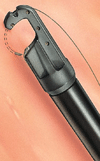During the same, very specific surgical operation
 GvEA, 10 september 2008, zaak T-325/06, Boston Scientific Ltd tegen OHIM / Terumo Kabushiki Kaisha (Nederlandse vertaling nog niet beschikbaar).
GvEA, 10 september 2008, zaak T-325/06, Boston Scientific Ltd tegen OHIM / Terumo Kabushiki Kaisha (Nederlandse vertaling nog niet beschikbaar).
Merkenrecht. Oppositieprocedure op grond van eerder nationale woordmerken CAPIOX, voor, kort gezegd, medische apparatuur, tegen aanvraag gemeenschapswoordmerk CAPIO (‘apparatus for placing a suture’). Complementaire waren, overeenstemmende tekens. Normaal gebruik in verhouding tot de aard van de waar en de markt. Oppositie toegewezen.
“49. It is true that, although such sales during the relevant period cannot be considered to be significant in terms of volume, the data must be viewed in relation to the nature of the goods, namely hollow fiber oxygenators with detachable hard-shell reservoir, which are extremely specialised products. According to the findings in the opposition decision, which were not contested by the intervener and which were expressly approved by the applicant in its application, ‘an oxygenator is a device that mechanically oxygenates venous blood extra corporeally and is used in combination with one or more pumps for maintaining circulation during open heart surgery and for assisting the circulation in patients seriously ill with some cardiac and pulmonary disorders’. That definition clearly shows that oxygenators are very specific products.
50. In addition, notwithstanding the regrettable lack of objective and tangible data concerning the structure of the relevant market, it is clear that, in the light, precisely, of the nature of the goods concerned, referred to in the previous paragraph, such a market cannot but be narrow.
51. Finally, the number of transactions involving the goods concerned during the relevant period does not appear to be a token amount and therefore does not permit the view to be taken that the intervener used the CAPIOX trade mark for the sole purpose of preserving the rights conferred by the trade mark. On the contrary, such use must be viewed as warranted, in the economic sector concerned and in the light of the nature of the goods concerned, in order to maintain or create a share in the market for the goods protected by the mark for the purposes of the case-law referred to in paragraphs 29 to 32 above.
(…) 95. The similarity between the signs at issue cannot be called into question on the ground that use of the letter ‘x’ is not common in Finland. Even if it were the case, as the Opposition Division stated, that the letter ‘x’ was seldom used in Finnish, that cannot have the effect of eliminating the similarity between the signs, because, as the Board of Appeal rightly pointed out in paragraph 27 of the contested decision, the medical field is highly internationalised and numerous trade marks that include the letter ‘x’ coexist in it.
96 (…) Consequently, the Board of Appeal was right to find that the conflicting signs had a high degree of similarity.
99. (…) the overall impression produced by the conflicting signs is likely to render them sufficiently similar to lead to a likelihood of confusion in the minds of the relevant public.
(…) 101. In that respect, it must be pointed out that even though the goods at issue lack a high degree of similarity that is offset by the very high degree of similarity between the signs, particularly as the earlier trade mark is an invented word that does not allude, directly or indirectly, to the goods concerned. Since the trade mark CAPIOX is a made-up word, it therefore has a very distinctive character as OHIM rightly observed. (…)
102. (…) even a public made up of specialists with a high degree of attention might, when confronted with the goods at issue, either not notice the difference resulting from the absence of the letter ‘x’ on goods bearing the trade mark applied for or think that the goods nevertheless originate from the same undertaking, which affixes a trade mark to some of its goods that is practically identical to the one it affixes to other of its goods. It is clear that the mere possibility mentioned above that the goods at issue could be used during the same, very specific surgical operation, namely open-heart surgery, shows that there is a genuine likelihood that a public, even one made up of professionals, could believe that the goods came from the same undertaking.”
Lees het arrest hier.





















































































